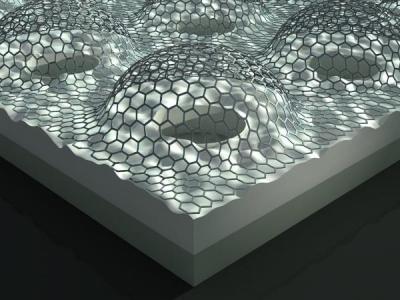A research team at the University of Colorado Boulder has discovered the astonishingly powerful adhesion properties of graphene during a study financed mainly by the Defense Advanced Research Projects Agency and the National Science Foundation.
 Artist's rendering of an array of pressurized graphene membranes
Artist's rendering of an array of pressurized graphene membranes
According to the research team led by Scott Bunch of the University of Colorado Boulder, the new findings would assist the large-scale production of graphene as well as graphene-made mechanical instruments such as gas separation membranes and resonators. The study demonstrated that the high flexibility of graphene enables it to suit even the surface of highly-smooth substrates.
Bunch stated that graphene is the world’s strongest, toughest and the thinnest material and has superior thermal and electrical conductivity. It is also impermeable to all normal gases and its newly revealed adhesion properties can now be included in its list of apparently contradictory properties, he said.
In order to obtain a quantified value of the adhesion between graphene and glass plates the research team utilized a pressurized blister test and determined the adhesion energy of one to five atomic layers of graphene sheets using a glass substrate. During the study, the researchers observed that van der Waals forces, the sum of the repulsive or attractive forces between molecules, cause adhesion of the graphene sheets to the glass substrates and also clamp collectively the single graphene sheets in multilayer samples.
Bunch further said that the research team observed that the adhesion energies between the glass substrate and graphene were comparatively higher than that of normal micromechanical structures.